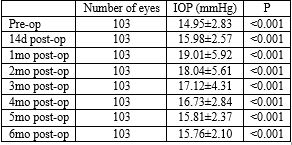A Study on Intraocular Pressure Elevation after Intravitreal 4mg Triamcinolone Acetonide Injection in treatment of macular edema
Abstract
Introduction: Macular edema is one of the leading causes of impaired vision in some retinalvascular disorders. Recent clinical studies suggest that intravitreal injection of triamcinoloneacetonide (IVTA) may be a therapeutic option for the treatment of macular edema. In 1995, Penfoldet al reported a pilot study of intravitreal injection of 4mg of triamcinolone acetonide (IVTA) to treatexudative age-related macular degeneration with encouraging results.
Materials and Methods: Aprospective, non-comparative study was performed with 87 patients (103 eyes) who received4mg/0.1mL (40g/L) IVTA injection for macular edema and who were followed up for a minimum of 3months at the Department of Ophthalmology. Patients using steroidal eye drops or systemicsteroids, those previously treated with subconjunctival or subtenon steroid injections and those witha prior history of glaucoma were excluded from the study.
Results: Of the 103 eyes, the mean agewas 56.3±11.4 years. Indication for the IVTA was progressive declining of visual acuity due tomacular edema associated with retinal venous occlusive disorders or diabetic retinopathy. IOPincreased significantly (p<0.001) from 14.95±2.83 mmHg preoperatively to a mean maximum of19.01±5.92 mmHg postoperatively.
Conclusion: According to our results, intravitreal injection of4mg of triamcinolone acetonide can lead to significant IOP elevation in approximately one-third ofpatients, occurring at a mean of 4 weeks after injection. The findings of our study suggest that theIVTA in a dosage of 4 mg could lead to secondary ocular hypertension.
Downloads
References
Penfold PL, Gyory JF, Hunyor AB, Billson FA. Exudative macular degeneration and intravitreal triamcinolone. A pilot study. Aust N Z J Ophthalmol. 1995 Nov;23(4):293-8. doi: 10.1111/j.1442-9071.1995.tb00179.x.
Young S, Larkin G, Branley M, Lightman S. Safety and efficacy of intravitreal triamcinolone for cystoid macular oedema in uveitis. Clin Exp Ophthalmol. 2001 Feb;29(1):2-6. doi: 10.1046/j.1442-9071.2001.00360.x.
Greenberg PB, Martidis A, Rogers AH, Duker JS, Reichel E. Intravitreal triamcinolone acetonide for macular oedema due to central retinal vein occlusion. Br J Ophthalmol. 2002 Feb;86(2):247-8. doi: 10.1136/bjo.86.2.247.
.
Jonas JB, Söfker A. Intraocular injection of crystalline cortisone as adjunctive treatment of diabetic macular edema. Am J Ophthalmol. 2001 Sep;132(3):425-7. doi: 10.1016/s0002-9394(01)01010-8.
Danis RP, Ciulla TA, Pratt LM, Anliker W. Intravitreal triamcinolone acetonide in exudative age-related macular degeneration. Retina. 2000;20(3):244-50.
McLean JM. Use of ACTH and cortisone. Trans Am Ophthalmol Soc1950;48:293–6.
Francois J. Cortisone et tension oculaire [Cortisone and eye strain]. Ann Ocul (Paris). 1954 Sep;187(9):805-16. French.
Graham RO, Peyman GA. Intravitreal injection of dexamethasone. Treatment of experimentally induced endophthalmitis. Arch Ophthalmol. 1974 Aug;92(2):149-54. doi: 10.1001/archopht.1974.01010010155016.
Beer PM, Bakri SJ, Singh RJ, Liu W, Peters GB 3rd, Miller M. Intraocular concentration and pharmacokinetics of triamcinolone acetonide after a single intravitreal injection. Ophthalmology. 2003 Apr;110(4):681-6. doi: 10.1016/S0161-6420(02)01969-3.
Jonas JB. Intraocular availability of triamcinolone acetonide after intravitreal injection. Am J Ophthalmol. 2004 Mar;137(3):560-2. doi: 10.1016/j.ajo.2003.08.012.
Martidis A, Duker JS, Greenberg PB, Rogers AH, Puliafito CA, Reichel E, et al. Intravitreal triamcinolone for refractory diabetic macular edema. Ophthalmology. 2002 May;109(5):920-7. doi: 10.1016/s0161-6420(02)00975-2.
Ip MS, Kumar KS. Intravitreous triamcinolone acetonide as treatment for macular edema from central retinal vein occlusion. Arch Ophthalmol. 2002 Sep;120(9):1217-9.
Antcliff RJ, Spalton DJ, Stanford MR, Graham EM, ffytche TJ, Marshall J. Intravitreal triamcinolone for uveitic cystoid macular edema: an optical coherence tomography study. Ophthalmology. 2001 Apr;108(4):765-72. doi: 10.1016/s0161-6420(00)00658-8.
Benhamou N, Massin P, Haouchine B, Audren F, Tadayoni R, Gaudric A. Intravitreal triamcinolone for refractory pseudophakic macular edema. Am J Ophthalmol. 2003 Feb;135(2):246-9. doi: 10.1016/s0002-9394(02)01938-4.
Tano Y, Chandler D, Machemer R. Treatment of intraocular proliferation with intravitreal injection of triamcinolone acetonide. Am J Ophthalmol. 1980 Dec;90(6):810-6. doi: 10.1016/s0002-9394(14)75196-7.
Danis RP, Bingaman DP, Yang Y, Ladd B. Inhibition of preretinal and optic nerve head neovascularization in pigs by intravitreal triamcinolone acetonide. Ophthalmology. 1996 Dec;103(12):2099-104. doi: 10.1016/s0161-6420(96)30383-7.
Jonas JB, Degenring RF, Kreissig I, Akkoyun I, Kamppeter BA. Intraocular pressure elevation after intravitreal triamcinolone acetonide injection. Ophthalmology. 2005 Apr;112(4):593-8. doi: 10.1016/j.ophtha.2004.10.042.
Smithen LM, Ober MD, Maranan L, Spaide RF. Intravitreal triamcinolone acetonide and intraocular pressure. Am J Ophthalmol. 2004 Nov;138(5):740-3. doi: 10.1016/j.ajo.2004.06.067.
Wilson CA, Berkowitz BA, Sato Y, Ando N, Handa JT, de Juan E Jr. Treatment with intravitreal steroid reduces blood-retinal barrier breakdown due to retinal photocoagulation. Arch Ophthalmol. 1992 Aug;110(8):1155-9. doi: 10.1001/archopht.1992.01080200135041.
Zhang, Y. B., X. L. Cheng, and J. Dong. Treatment of diabetic macular edema by dual intravitreal injections of triamcinolone. Int J Ophthalmol (Guoji Yanke Zazhi) 5.6 (2005): 1207-1210.
Ozkiris A, Evereklioglu C, Erkiliç K, Tamçelik N, Mirza E. Intravitreal triamcinolone acetonide injection as primary treatment for diabetic macular edema. Eur J Ophthalmol. 2004 Nov-Dec;14(6):543-9.
Ciulla TA, Walker JD, Fong DS, Criswell MH. Corticosteroids in posterior segment disease: an update on new delivery systems and new indications. Curr Opin Ophthalmol. 2004 Jun;15(3):211-20. doi: 10.1097/01.icu.0000120711.35941.76.
Becker B, Bresnick G, Chevrette L, Kolker AE, Oaks MC, Cibis A. Intraocular pressure and its response to topical corticosteroids in diabetes. Arch Ophthalmol. 1966 Oct;76(4):477-83. doi: 10.1001/archopht.1966.03850010479003.
Hirooka K, Shiraga F, Tanaka S, Baba T, Mandai H. Risk factors for elevated intraocular pressure after trans-tenon retrobulbar injections of triamcinolone. Jpn J Ophthalmol. 2006 May-Jun;50(3):235-8. doi: 10.1007/s10384-005-0306-9.
Floman N, Zor U. Mechanism of steroid action in ocular inflammation: Inhibition of prostaglandin production. Invest Ophthalmol Vis Sci. 1977 Jan;16(1):69-73.
Hirooka K, Shiraga F, Tanaka S, Baba T, Mandai H. Risk factors for elevated intraocular pressure after trans-tenon retrobulbar injections of triamcinolone. Jpn J Ophthalmol. 2006 May-Jun;50(3):235-8. doi: 10.1007/s10384-005-0306-9.

Copyright (c) 2022 Author (s). Published by Siddharth Health Research and Social Welfare Society

This work is licensed under a Creative Commons Attribution 4.0 International License.


 OAI - Open Archives Initiative
OAI - Open Archives Initiative



















 Therapoid
Therapoid

